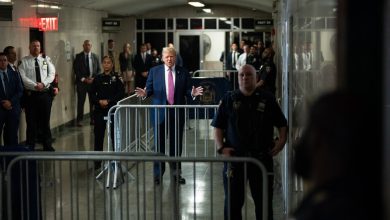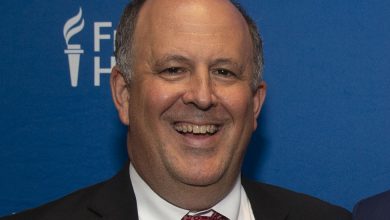‘Podcast Movies’? Feature-length Fiction Stretches the Medium

What do you call a podcast that presents a single, fictional story in 90 minutes? It might feel like a movie but clearly isn’t one. It recalls midcentury radio drama but involves no radio.
“You could say ‘feature-length podcasts’ but that just seems boring,” said Chris Corcoran, the co-founder and chief content officer of Cadence13, a podcast production company. “You want to exemplify the experience in a way that feels forward-looking but is still legible to the consumer.”
Corcoran’s preferred term of art, “podcast movie,” mashes two distinct categories together, reflecting the exuberance — and confusion — of this moment of media upheaval. (Movies themselves were once self-consciously called “photoplays.”)
Whatever the new form’s ultimate name, the content has arrived. This fall, Cadence13 released its first two “podcast movies”: “Treat,” a Halloween teen horror story starring Kiernan Shipka, and “Ghostwriter,” a psychological thriller led by Kate Mara and Adam Scott. A third is in progress, and others are circling similar territory. In April, Two-Up, a Brooklyn-based entertainment company (“Limetown,” “36 Questions”) released a “feature-length audio movie” titled “Shipworm,” and the children’s podcast studio Gen-Z Media published the “movie-length audio epic” “Iowa Chapman and the Last Dog” in August.
“Why does the format have to be confined to this notion of serialized stories?” said Ben Davis, a partner at the Hollywood talent agency William Morris Endeavor, which is collaborating with Cadence13 on its features projects and represents Two-Up. “The maturation of podcasting can unlock new forms of creativity and new outlets for creators.”
Corcoran said he first thought of making feature-length podcasts in 2019, when Cadence13, then known for producing interview shows with prominent public figures like Gwyneth Paltrow and Deepak Chopra, was looking to get into fiction — a relatively small but growing segment of the industry.
At the time, fiction podcasts were typically anthologies (“Welcome to Night Vale,” “The Truth”) or serials (“Limetown,” “Homecoming”), formats that work smoothly in an industry that has historically depended on free subscriptions and advertising. A movielike podcast with no continuous supply of content would have struggled to lure subscribers, and therefore advertising dollars.
But two recent developments have smoothed the path toward features. First, the popularity of podcast-to-TV adaptations (Jessica Biel and Julia Roberts starred in shows based on “Limetown” and “Homecoming,” and Will Ferrell and Paul Rudd led the recent TV version of the podcast “The Shrink Next Door”) has attracted increasing interest from the feature film industry, where there is constant demand for proven intellectual property. Companies like QCode, Gimlet and Realm have been luring Hollywood talent to adaptation-friendly limited series for years. Feature-length audio is a logical next step.
Second, the introduction this year of paid subscription options to the two leading podcast platforms, Apple Podcasts and Spotify, enabled producers to offer new kinds of premium content that aren’t dependent on advertising. Though how many people are willing to pay for podcasts is still an open question — last year, the premium podcast app Luminary reduced its monthly price tag to $4.99 from $7.99 — podcast companies are incentivized to make that pie as big as possible.
Both “Treat” and “Ghostwriter” included ads, and neither was placed behind a paywall. But Corcoran said his company is considering restricting podcast movies to paid subscribers in the future. Even though the features, which were recorded in a matter of days, cost “much less” than producing a multi-episode series, Corcoran said, advertising alone wasn’t enough to cover their expense. The company hopes to make money by eventually selling the movie rights. (Corcoran declined to share specific budget figures or subscription pricing plans.)
“The business plan right now is to create a slate of premium I.P. and then turn that around for adaptations,” Corcoran said. “I think the writers, directors and other actors out there are going to see what’s happening and be glued to this.”
From a creative standpoint, the writers and actors involved in “Treat” and “Ghostwriter” were optimistic about the feature-length format. Alix Sobler, a playwright who wrote the script for “Ghostwriter,” said there were specific challenges to writing for audio — “Will the audience feel connected to this cat just by hearing it?” — but found the listening experience ultimately satisfying.
“I love that you’re getting a full story without having to sit down in a theater or in front of a television,” she said. “It’s a little more prescriptive than a book, because you hear voices and sounds, but you can still use your mind’s eye and get lost in it.”
Nathan Ballingrud, a short fiction writer who wrote “Treat” (which was initially conceived as a film), said he was unsure of the potential in audio until he heard the final product. “It wasn’t until I sat down on my couch and listened through it that I was like, ‘OK, this really works,” he said. “I hope it’s not the last one that I get to make.”
Perhaps no one was more pleased with the experience than the actors.
“It reminded me of these audio productions of the Star Wars movies that I used to get on tape as a kid,” said Scott. “It kind of brings you halfway there, and your imagination has to fill in the rest.”
There are practical benefits, as well. Where a film or television series can require a monthslong commitment, between preparation and filming, Mara said her lead role in “Ghostwriter” was recorded in just four days. She is also an executive producer of the project and will retain that role on any future adaptations.
“It was fun and really very, very easy,” Mara said. “You can go to work in your pajamas, if you want.”




